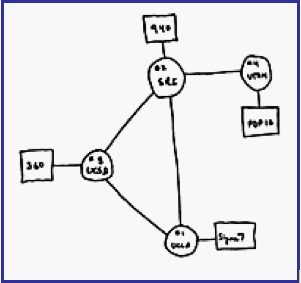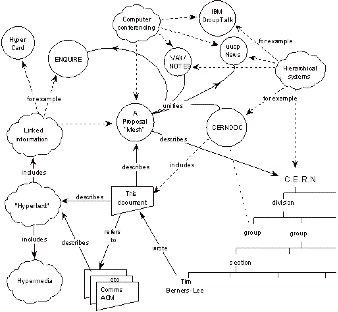
The Internet: A Brief History
On October 4, 1957, the Space Age began and the United States was catapulted into a technological frenzy. On this date, the Soviet Union released Sputnik I, the first artificial satellite, into space. (NASA)
Worried that the Soviet Union would overtake the United States' powerhouse standing, the Advanced Research Projects Agency (ARPA) was formed as a subunit of the Department of Defense. ARPA was to be a military research program that could survive a nuclear attack of some U.S. cities by decentralization. (Kristula)
In order to have such a goal, ARPA needed to have many access points to their information and control station. In 1969, the physical network for ARPANET was constructed. It linked just four hosts the University of California at Los Angeles, SRI at Stanford University, the University of California at Santa Barbara, and the University of Utah. (Kristula)

4-host ARPANET diagram (1974)
In just four years, the number of hosts rose from four to twenty-three, and the first email program was created. (Kristula) In 1974, Vint Cerf and Bob Kahn coined the term "Internet" in a paper on Transmission Control Protocol. In 1991, only eighteen years after the Internet was first introduced, the number of hosts had grown from 4 to 617,000 (that's an average of 34,278 hosts per year)! Of course, this was after many more upgrades of the lines and computers of the Internet. The next year, the World Wide Web (WWW) was released to the public and the number of hosts grew to 1,136,000. Finally, in 1995, the National Science Foundation (NSF) began charging a fee for domains (except .edu and .gov, which are still funded by the NSF). (Kristula)

WWW Proposal (1989)
By the end of 1992, the year when the WWW was released, it only contained a mere 50 web sites. The next year only saw an increase to 150 pages. However, in 1993, Mosaic X was released, which was easy to install, easy to use, and had an around-the-clock customer support system. It also drastically improved graphics capabilities and browser standards. (Griffiths)
Until now, the Web had served two main communities - the scientific community (accessing on-line documentation) and a wider 'netizens' (net citizens) community (accessing e-mail and news-group facilities). Now commercial web-sites began their proliferation, followed at a short distance by local school/club/family sites. These developments were accelerated by the appearance of ever-more powerful (and cheap) personal computers (which increased both the number of netizens and the potential market for businesses) and by the increase in capacity of the communications infrastructure. The Web now exploded. (Griffiths)
In January 2001, there were an estimated 110 million hosts and 30 million websites. (Griffiths) This means the number of webpages is in the billions! So, how does one go about wading through so many sites and pages in order to find the needed information?
Continue
[Letter]
[Activity 00309-01]
[Back to Top]
[Glossary]
[Concept Answers]
[Alphabetical Glossary]
[Contact Author]
This material is based upon work supported by National Science Foundation under Grant No. 0546622.
Any opinions, findings, and conclusions or recommendations expressed in this material are those of the
author and do not necessarily reflect the views of the National Science Foundation.


